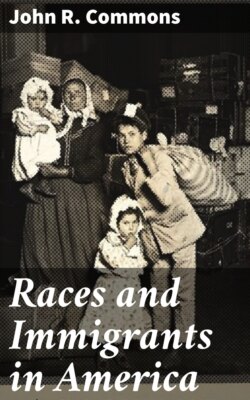Читать книгу Races and Immigrants in America - John R. Commons - Страница 9
На сайте Литреса книга снята с продажи.
COLONIAL RACE ELEMENTS
ОглавлениеTable of Contents
Doubtless the most fascinating topic in the study of races is that of the great men whom each race has produced. The personal interest surrounding those who have gained eminence carries us back over each step of their careers to their childhood, their parents, and their ancestry.[6] Pride of race adds its zest, and each race has its eulogists who claim every great man whose family tree reveals even a single ancestor, male or female, near or remote, of the eulogized race. Here is a “conflict of jurisdiction,” and the student who is without race prejudice begins to look for causes other than race origin to which should be ascribed the emergence of greatness.
Mr. Henry Cabot Lodge[7] attempted, some years ago, to assign to the different races in America the 14,243 men eminent enough to find a place in “Appleton’s Encyclopedia of American Biography.” He prepared a statistical summary as follows:—
EMINENT AMERICANS
| English | 10,376 | |
| Scotch-Irish | 1,439 | |
| German | 659 | |
| Huguenot | 589 | |
| Scotch | 436 | |
| Dutch | 336 | |
| Welsh | 159 | |
| Irish | 109 | |
| French | 85 | |
| Scandinavian | 31 | |
| Spanish | 7 | |
| Italian | 7 | |
| Swiss | 5 | |
| Greek | 3 | |
| Russian | 1 | |
| Polish | 1 | |
| Total | 14,243 |
When we inquire into the methods necessarily adopted in preparing a statistical table of this kind we discover serious limitations. Mr. Lodge was confined to the paternal line alone, but if, as some biologists assert, the female is the conservative element which holds to the type, and the male is the variable element which departs from the type, then the specific contribution of the race factor would be found in the maternal line. However, let this dubious point pass. We find that in American life two hundred years of intermingling has in many if not in most cases of greatness broken into the continuity of race. True, the New England and Virginia stock has remained during most of this time of purely English origin, but the very fact that in Mr. Lodge’s tables Massachusetts has produced 2686 notables, while Virginia, of the same blood, has produced only 1038, must lead to the suspicion that factors other than race extraction are the mainspring of greatness.
It must be remembered that ability is not identical with eminence. Ability is the product of ancestry and training. Eminence is an accident of social conditions. The English race was the main contributor to population during the seventeenth century, and English conquest determined the form of government, the language, and the opportunities for individual advancement. During the succeeding century the Scotch-Irish and the Germans migrated in nearly equal numbers, and their combined migration was perhaps as great as that of the English in the seventeenth century. But they were compelled to move to the interior, to become frontiersmen, to earn their living directly from the soil, and to leave to their English-sprung predecessors the more prominent occupations of politics, literature, law, commerce, and the army. The Germans, who, according to Lodge, “produced fewer men of ability than any other race in the United States,” were further handicapped by their language and isolation, which continue to this day in the counties of Pennsylvania where they originally settled. On the other hand, the Huguenots and the Dutch came in the first century of colonization. They rapidly merged with the English, lost their language, and hence contributed their full share of eminence. Finally, the Irish, Scandinavian and other races, inconspicuous in the galaxy of notables, did not migrate in numbers until the middle of the nineteenth century, and, in addition to the restraints of language and poverty, they found the roads to prominence preoccupied.
